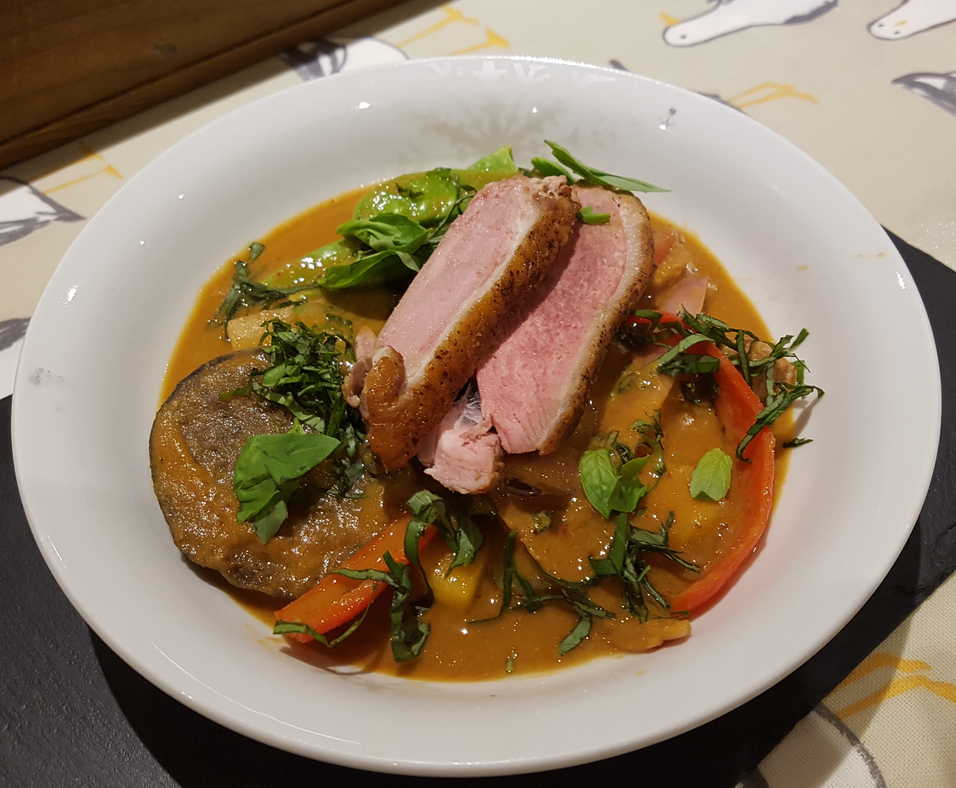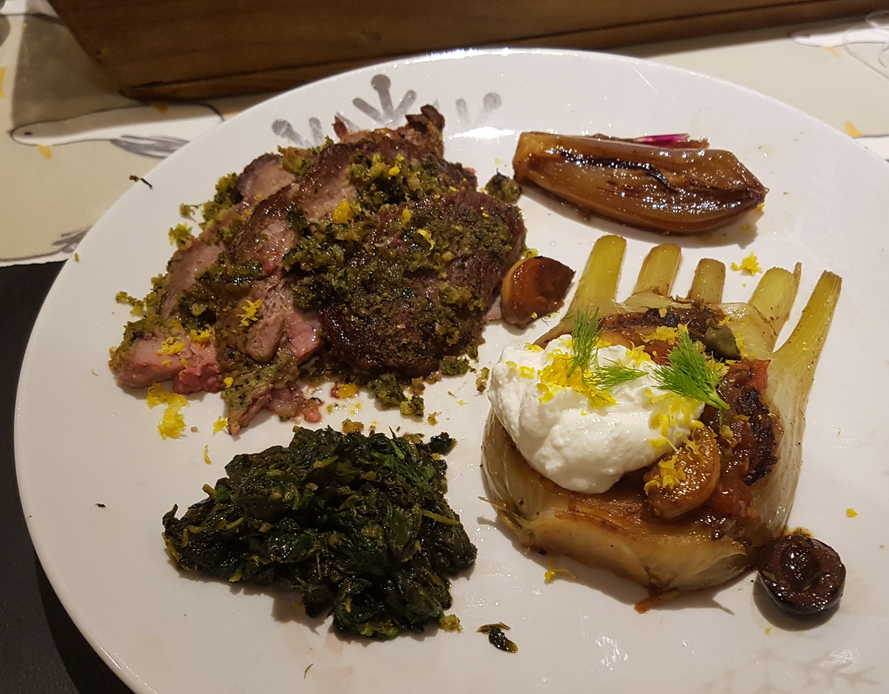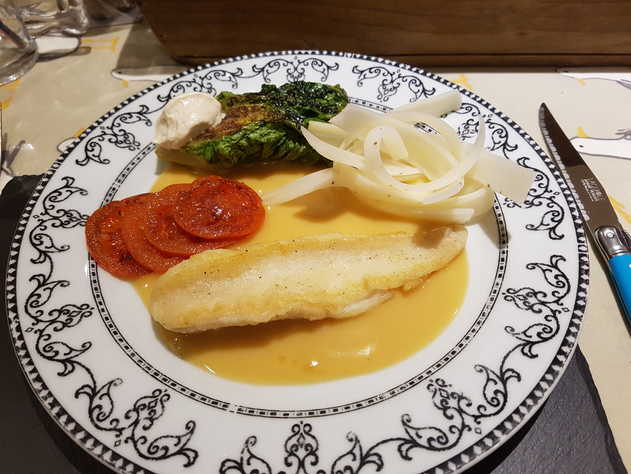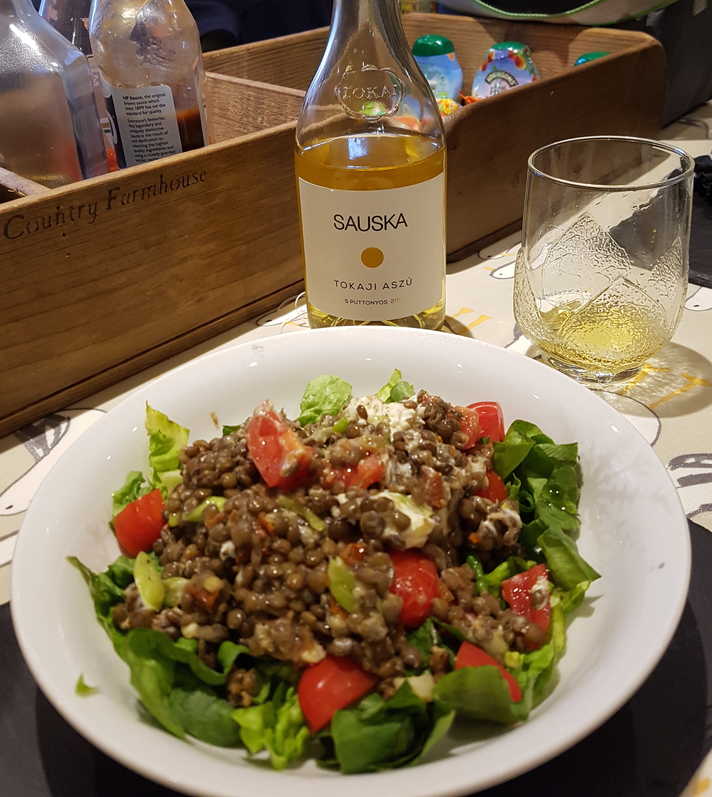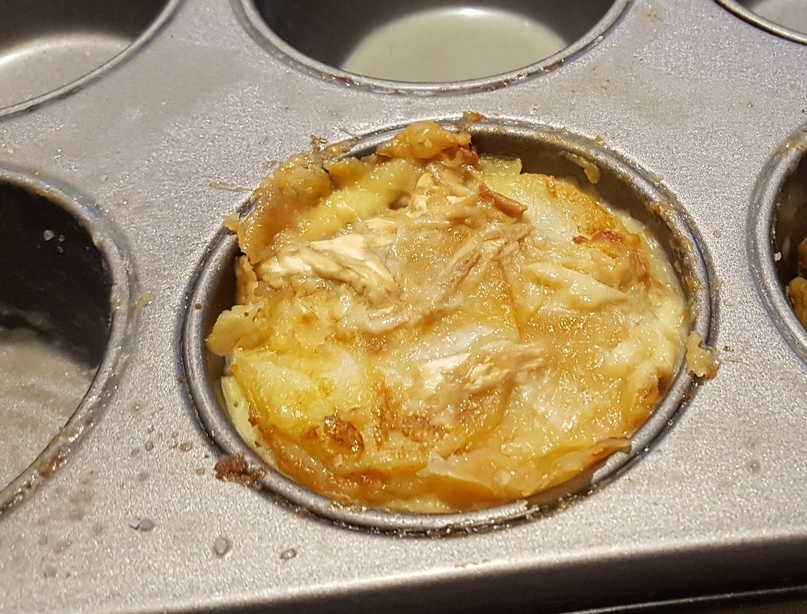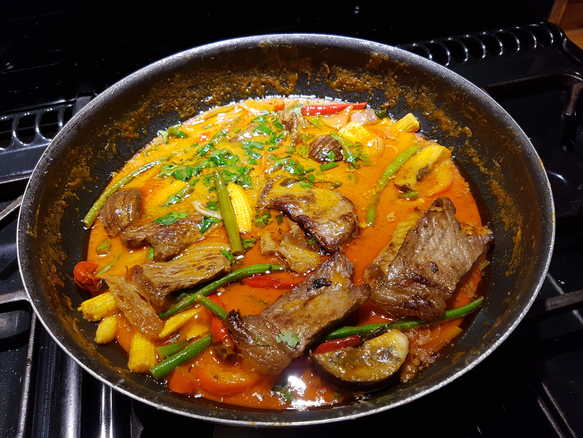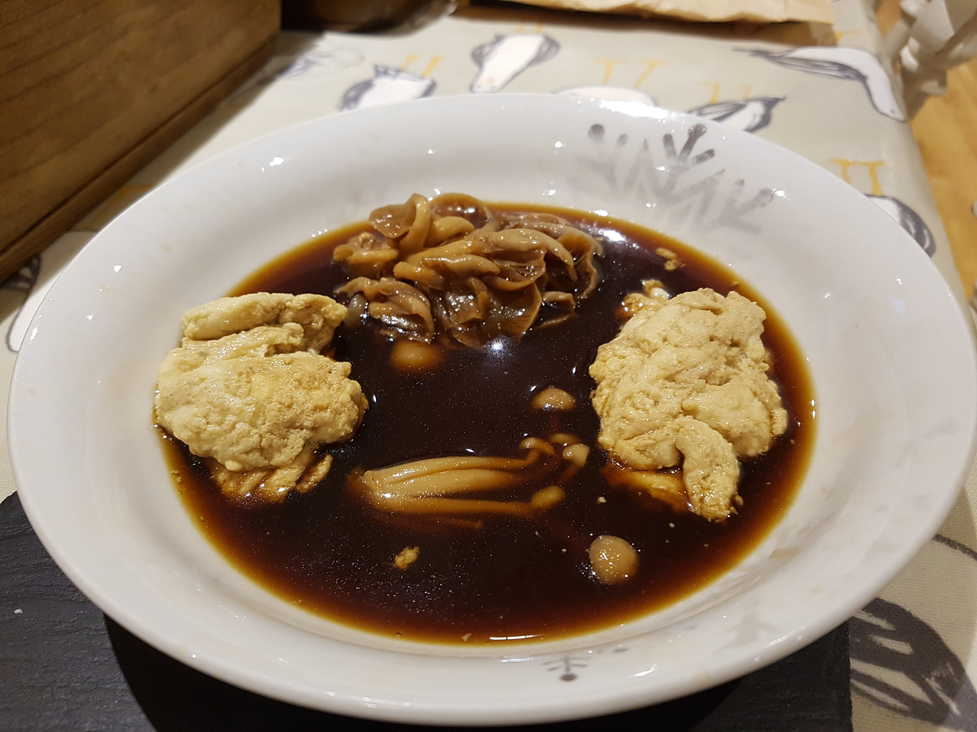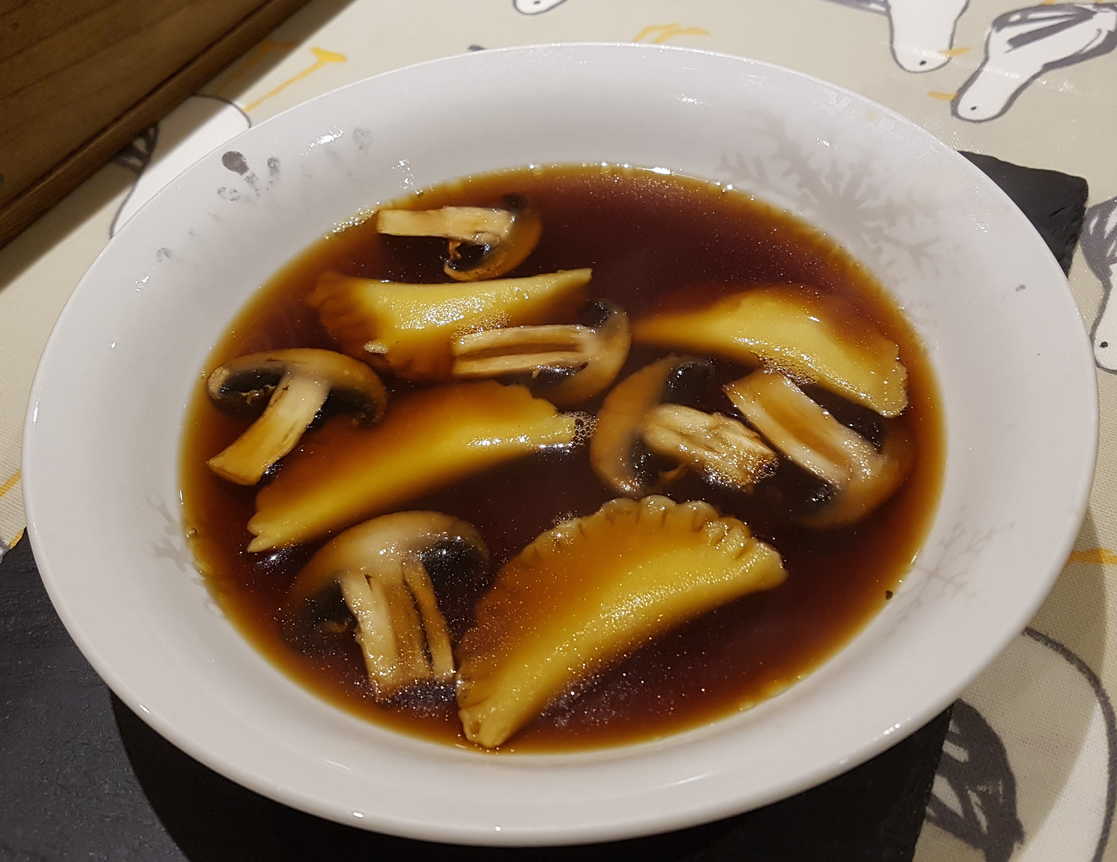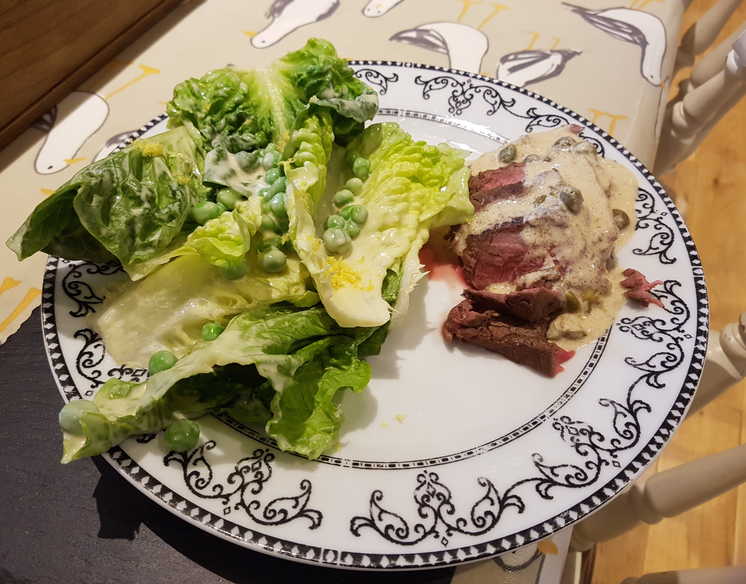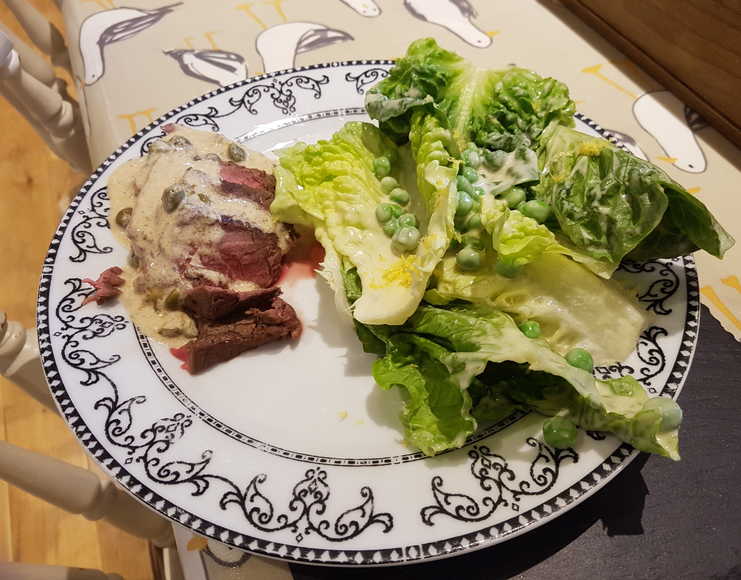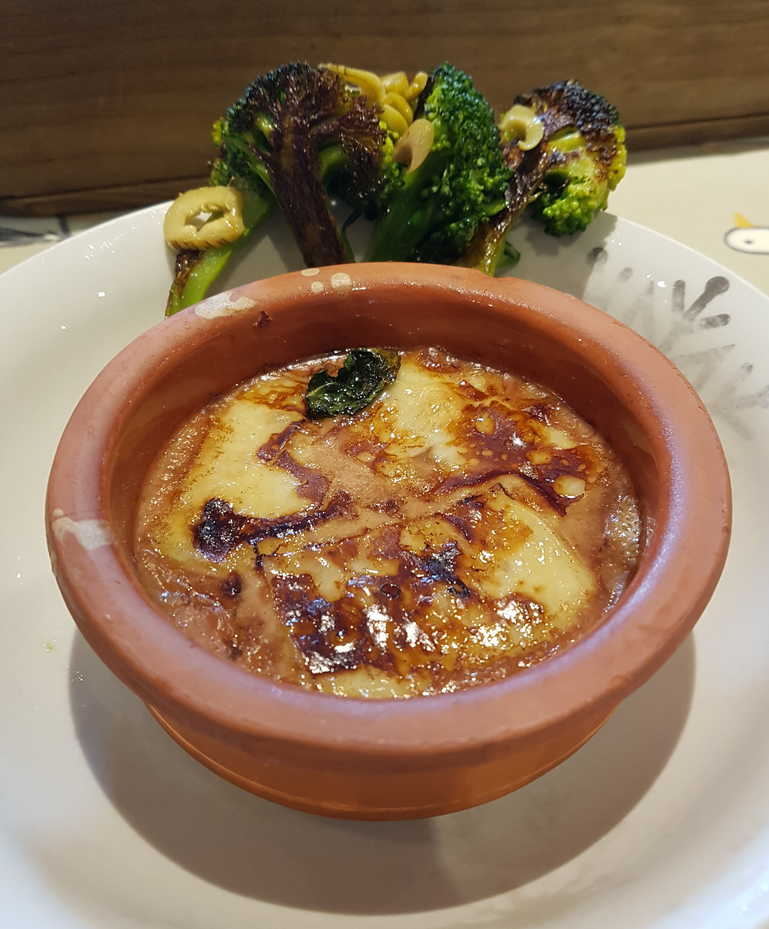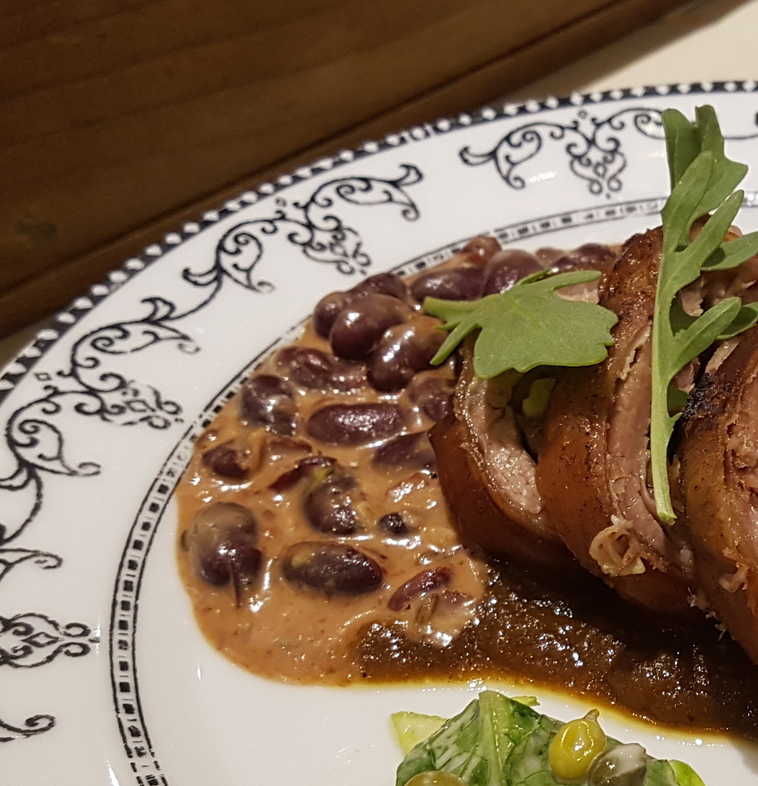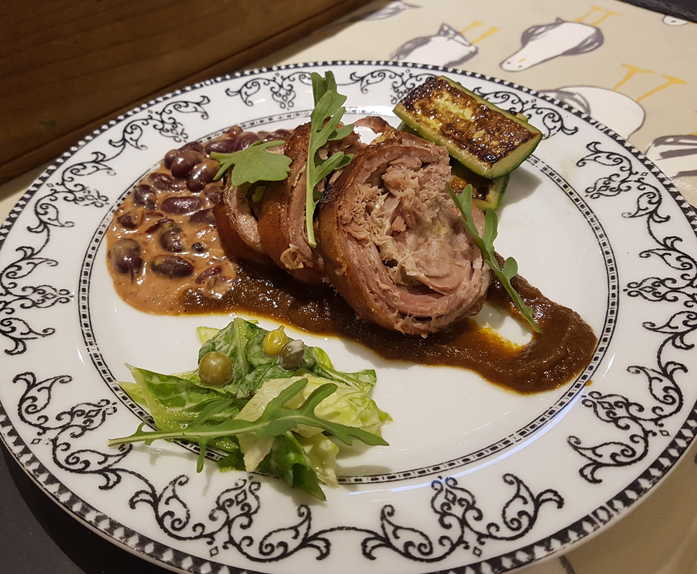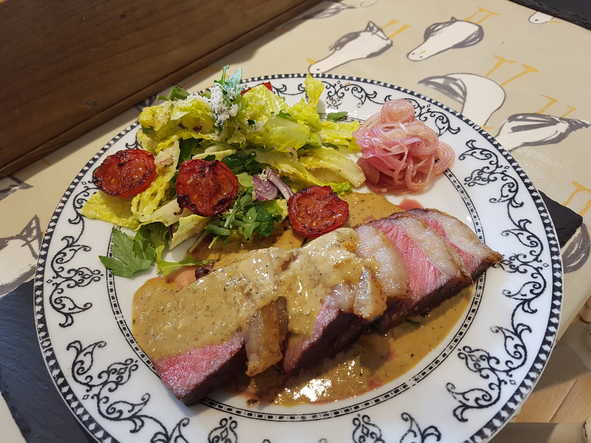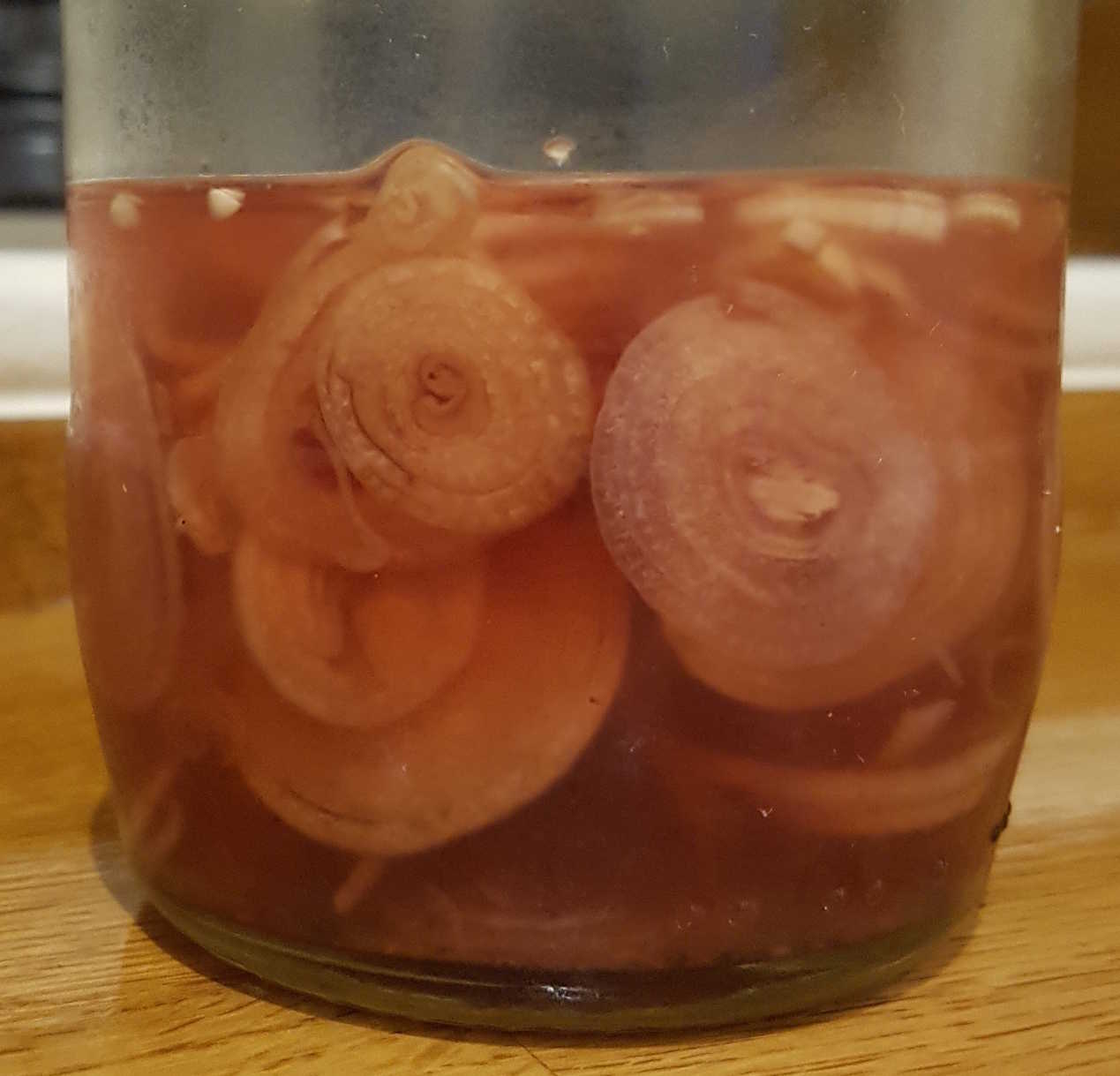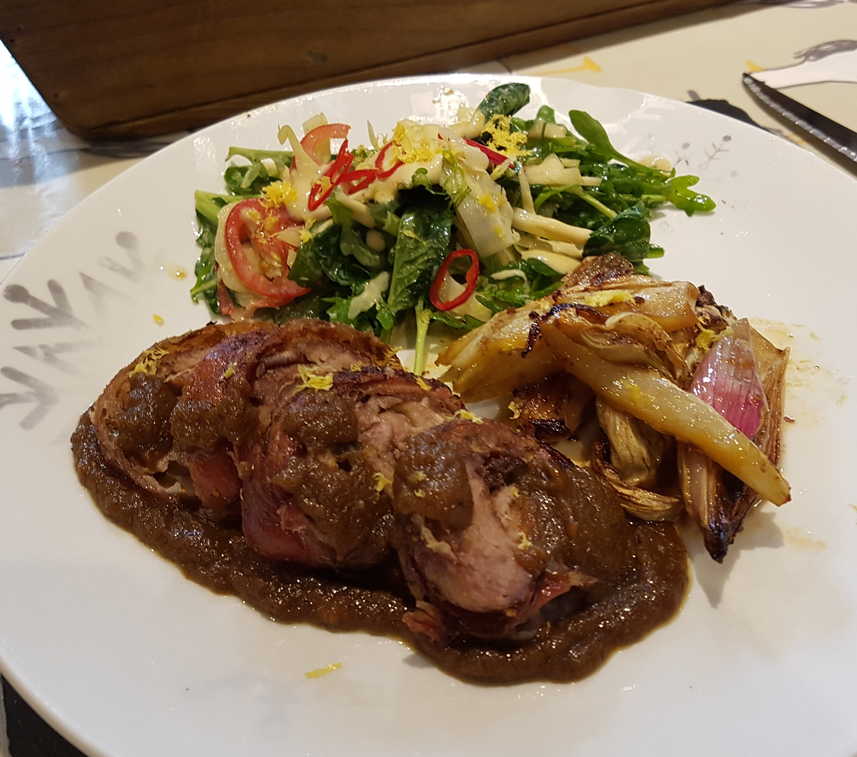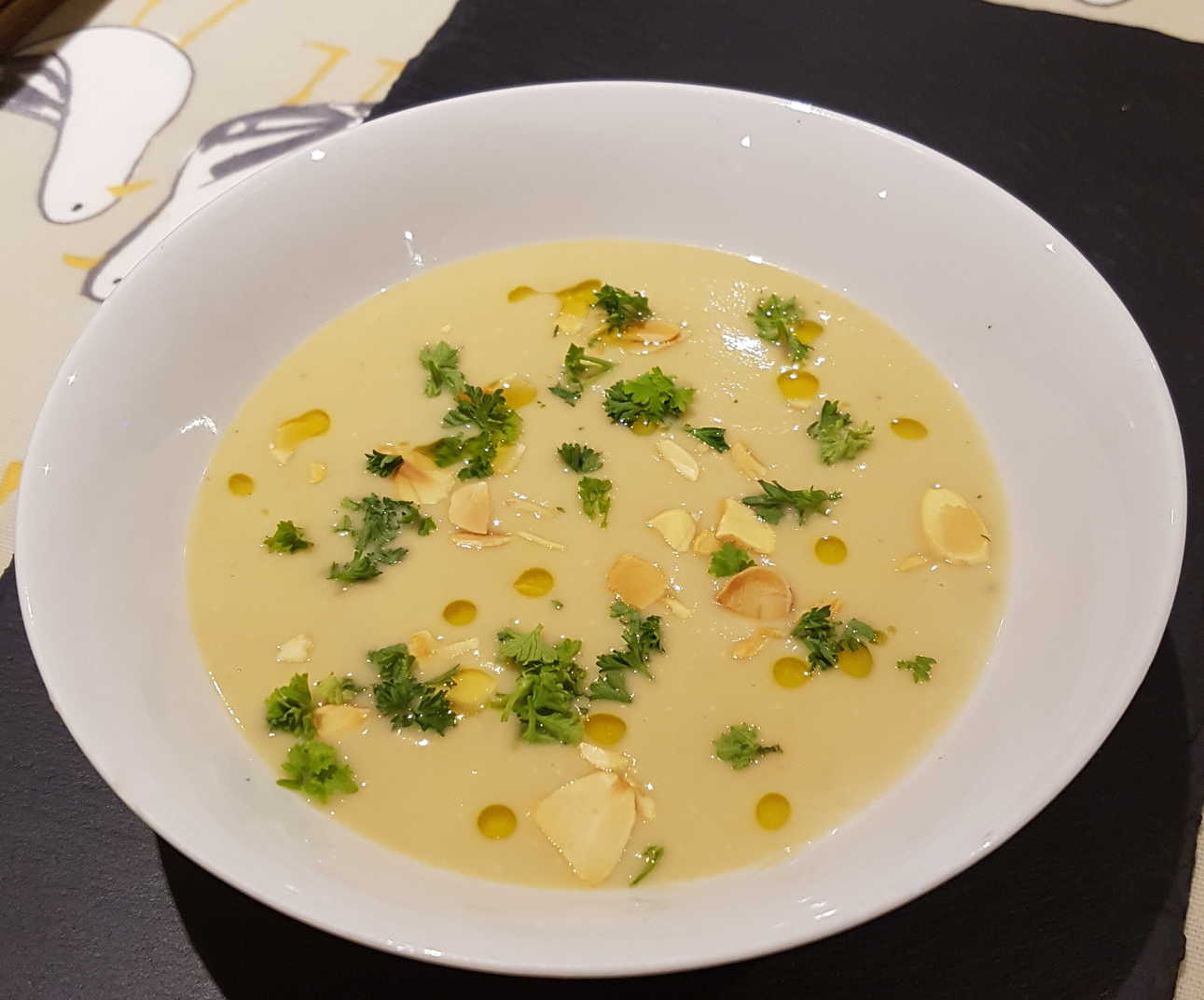
2000!

Two thousand recipes!
Why, it seems like only last decade when all I had on this site were a measly thousand recipes. How time flies! I got a bit of a leg up at the beginning by copying out all my old recipe notebooks, and a lot of annotated recipes from my cookbooks, but things really slowed down when I had to start inventing them myself. Though truth be told, only about 500 of the recipes are actually mine.
Anyhoo, here are a few of the recipes I knocked up this week.
Since I bought a tub of Thai red curry paste before Christmas to spice up my annual Tom Kha Kai, and since that only took about a tablespoon, I've had a lot of Thai red curry paste to use up. Can you tell? Good thing it lasts a looong time.
Or is it?
Cauliflower and Cashel Blue Soup
veg soup cheese
Other cheeses are available, blue or not.
Might be nice with a touch of fennel? Maybe a teaspoon of mustard, depending on the cheese.
Might be nice with a touch of fennel? Maybe a teaspoon of mustard, depending on the cheese.
Serves 4
Ingredients
- butter and olive oil
- 1 cauliflower
- 1 rib celery
- 1 onion
- 1 potato
- 1 garlic clove
- 100-200g Cashel Blue cheese
- 1 litre stock
- splash Worcestershire sauce
- pinch nutmeg
- 100ml cream
- salt & pepper
To Serve:- flaked almonds, toasted
- parsley, chopped
- truffle oil
Chop the cauliflower, potato, onion, celery and garlic and sweat gently in a knob of butter and a splash of olive oil without browning until they soften.
Blend until smooth with the stock and cheese to taste.
Reheat gently. Season. Swirl through cream. Serve with toasted almond flakes, chopped parsley and a drizzle of olive or truffle oil.
Blend until smooth with the stock and cheese to taste.
Reheat gently. Season. Swirl through cream. Serve with toasted almond flakes, chopped parsley and a drizzle of olive or truffle oil.
The Cashel gives it a hint of metal flavour, if I'm honest. But the idea is sound 🙂
Thai Red Curry Duck
main fowl curry thai
I made a very complicated version of this so you don't have to. Probably the simpler the better really.
I started with a whole duck and split it into legs and breasts, removed the skin from the legs and one breast and marinated those in the blended marinade ingredients below. These I then cooked in the sauce.
The other breast I pan-fried, skin-down, finished off in the oven, then sliced up to serve on top.
Some things I learned:
I also chopped the removed duck skin into 1" pieces (well, some of it), cooked them in a pan (with a few tablespoons of water to stop it sticking) over a low heat for about an hour until it rendered out all the fat and the pieces became crispy.
Some things else I learned:
I started with a whole duck and split it into legs and breasts, removed the skin from the legs and one breast and marinated those in the blended marinade ingredients below. These I then cooked in the sauce.
The other breast I pan-fried, skin-down, finished off in the oven, then sliced up to serve on top.
Some things I learned:
- Don't bother marinating the duck meat - it just turns soft and spongy with no real flavour payoff to speak of.
- Don't add soy sauce to the curry, it turns the sauce a disappointing brown colour.
- You really won't need all the fruit and vegetables listed below. Just pick a few.
I also chopped the removed duck skin into 1" pieces (well, some of it), cooked them in a pan (with a few tablespoons of water to stop it sticking) over a low heat for about an hour until it rendered out all the fat and the pieces became crispy.
Some things else I learned:
- Crispy rendered duck skin makes a very tasty garnish.
- While being rendered, duck skin will occasionally explode and spray boiling hot fat over anything within range.
Serves 4
Ingredients
- duck breasts
- groundnut oil
- coconut milk
- red curry paste
- fish sauce
- palm sugar
Optional Vegetables:- shallots, whole or sliced into 4, 6 or 8
- bamboo shoots
- mange tout
- red chillies, sliced, preferably long mild ones
- baby corn, sliced
- cherry tomatoes
- aubergine, sliced or diced, or baby
- grapes, halved if large
- pineapple, chunked
- lychees, peeled, stoned
For the Marinade:- zest and juice of 1 lime
- handful of pineapple pieces
- bunch coriander root/stalks
- 2" ginger/galangal
- 2 cloves garlic
- soy sauce
- 1 tablespoon oil
- 1 teaspoon red curry paste
To Serve:- coriander
- Thai basil
- kaffir lime leaves
- crispy duck skin
First of all, forget the marinade. It's not worth it. You could, if you wanted to, blend all the marinade ingredients except the soy sauce
and just add them to the sauce later, after frying the red curry paste. If you really wanted to. Or you could just throw in the lime and some galangal slices.
Score the skin of a couple of duck breasts, season them well, and put them in a cold frying pan over a low heat. Render them gently, occasionally spooning off excess fat, until the skin turns golden and crispy. Flip them over for a few minutes to cook the flesh side, then pop them uncovered, skin-side up, in the oven to finish off or keep warm.
I think this would traditionally be done using the thick coconut cream that has risen to the top of your coconut milk. However if, like me, you bought your coconut milk in a tin in the Local Fucking Supermarket™ then your coconut milk will be full of emulsifiers and guar gum, and the thick scum that floats to the top won't reduce and fry like real coconut cream.
So best just to use groundnut oil.
In a large pan heat a few tablespoons of groundnut oil, and fry the red curry paste until the harsh smell has cooked off and the oil separates. Add the rest of? the coconut milk. Stir well and heat through. You may want to thin the sauce with stock, pineapple juice, bamboo shoot water, or plain water if its too thick. Add any vegetables and fruit that you like. Cook briefly - they won't need long, then adjust the flavour with fish sauce, lime juice, and palm sugar. Slice the duck breasts along the scores in their skin. You can heat them through in the sauce if they aren't quite cooked, otherwise just lay them on top to serve.
Dress with chopped coriander, Thai basil or finely sliced kaffir lime leaves remove the stalks and a few duck skin crisps.
Score the skin of a couple of duck breasts, season them well, and put them in a cold frying pan over a low heat. Render them gently, occasionally spooning off excess fat, until the skin turns golden and crispy. Flip them over for a few minutes to cook the flesh side, then pop them uncovered, skin-side up, in the oven to finish off or keep warm.
Pick your fruit and vegetables:
Peel and core the pineapple, making sure to dig out the hard, spiky indentations in the skin too. Cut it into chunks.
Slice or chunk the aubergine unless you're using baby ones.
If you're using aubergines or pineapple, you might want to fry them up in some of that reserved duck fat to give them a little caramel colour.
Peel and slice banana shallots lengthwise into manageable pieces.
Remove grape seeds, if they have any, and halve any large seedless ones.
Peel and stone the lychees. Halve if large.
Drain the bamboo shoots (though you might want to keep some water).
Slice the chillies lengthways and remove the seeds. Long mild ones are good for this.
Cut the mangetout into bite-sized pieces.
Slice the baby corn.
It's best to fry the red curry paste first and cook off any of its harshness.Peel and core the pineapple, making sure to dig out the hard, spiky indentations in the skin too. Cut it into chunks.
Slice or chunk the aubergine unless you're using baby ones.
If you're using aubergines or pineapple, you might want to fry them up in some of that reserved duck fat to give them a little caramel colour.
Peel and slice banana shallots lengthwise into manageable pieces.
Remove grape seeds, if they have any, and halve any large seedless ones.
Peel and stone the lychees. Halve if large.
Drain the bamboo shoots (though you might want to keep some water).
Slice the chillies lengthways and remove the seeds. Long mild ones are good for this.
Cut the mangetout into bite-sized pieces.
Slice the baby corn.
I think this would traditionally be done using the thick coconut cream that has risen to the top of your coconut milk. However if, like me, you bought your coconut milk in a tin in the Local Fucking Supermarket™ then your coconut milk will be full of emulsifiers and guar gum, and the thick scum that floats to the top won't reduce and fry like real coconut cream.
So best just to use groundnut oil.
In a large pan heat a few tablespoons of groundnut oil, and fry the red curry paste until the harsh smell has cooked off and the oil separates. Add the rest of? the coconut milk. Stir well and heat through. You may want to thin the sauce with stock, pineapple juice, bamboo shoot water, or plain water if its too thick. Add any vegetables and fruit that you like. Cook briefly - they won't need long, then adjust the flavour with fish sauce, lime juice, and palm sugar. Slice the duck breasts along the scores in their skin. You can heat them through in the sauce if they aren't quite cooked, otherwise just lay them on top to serve.
Dress with chopped coriander, Thai basil or finely sliced kaffir lime leaves remove the stalks and a few duck skin crisps.
Easy. Right?
Amusingly named if not actually invented by Karl
Crispy Duck Skin Quacklings
fowl ingredient
Quacklings 🤣
A tasty treat for when you happen to have a spare duck skin lying around. God knows what you did with the rest of that naked duck.
A tasty treat for when you happen to have a spare duck skin lying around. God knows what you did with the rest of that naked duck.
Ingredients
- 1 duck
- 4 tablespoons (60ml) water
- seasoning
First peel your duck 😂
Cut the skin (or as much of it as you want to eat) into 1-2" pieces. Put them and any un-chopped skin in a heavy saucepan with a quarter cup of water to help stop them sticking and cook gently over a low to medium heating stirring occasionally, particularly at first. The liquid will start cloudy and bubbling, then after about 15 minutes will settle to clear rendered fat. Eventually after half an hour or so the skin pieces will turn golden and crispy.
Drain them, keeping the duck fat for roasting your potatoes, dry them on kitchen paper and season. You can use salt, pepper, sumac, za'atar, five spice powder or whatever you fancy.
Serve them immediately.
Cut the skin (or as much of it as you want to eat) into 1-2" pieces. Put them and any un-chopped skin in a heavy saucepan with a quarter cup of water to help stop them sticking and cook gently over a low to medium heating stirring occasionally, particularly at first. The liquid will start cloudy and bubbling, then after about 15 minutes will settle to clear rendered fat. Eventually after half an hour or so the skin pieces will turn golden and crispy.
Drain them, keeping the duck fat for roasting your potatoes, dry them on kitchen paper and season. You can use salt, pepper, sumac, za'atar, five spice powder or whatever you fancy.
Serve them immediately.
Be aware while rendering the skin pieces that they may occasionally explode and blind you with bullets of hot fat.
Braised Fennel with Capers and Olives
side veg
I find fennel to be quite a challengingly insipid vegetable to cook with.
This recipe makes the most of it though - it's packed with Mediterranean flavours that all work very well together.
You'll hardly notice that it's got fennel in it!
I made it using one large fennel and about half the other quantities. Though I did have extra, extra, olives. It seems quite forgiving, quantity-wise.
I made it using one large fennel and about half the other quantities. Though I did have extra, extra, olives. It seems quite forgiving, quantity-wise.
Serves 4
Ingredients
- 4 medium fennel bulbs
- 3 tbsp olive oil, plus extra for drizzling
- Salt and black pepper
- 15 large whole garlic cloves yes, really!, skin on
- 4 tbsp verjuice (or 4 tbsp lemon juice mixed with 2 tbsp red-wine vinegar)
- 1 medium tomato, cut into 1cm dice
- 250ml fresh vegetable stock
- 20g capers, drained
- 25g black wrinkly olives, pitted and chopped in half
- 1 tbsp chopped thyme leaves
- 2½ tsp caster sugar
- 100g ricotta
- 1 tsp grated lemon zest
First prepare the fennel. Trim off and discard the tops (reserve any leafy fronds for garnish) and cut each bulb in half from top to bottom;
you are aiming for thick slices about 2.5cm wide.
In a large frying pan for which you have a lid, heat two and a half tablespoons of oil on a medium to high heat. Add half the fennel with an eighth of a teaspoon of salt and some black pepper. Cook for five or six minutes, turning once, so it's nicely brown on both sides, remove from the pan and repeat with the remaining fennel.
Keep the empty pan on the heat, pour in the remaining oil, add the garlic and fry for three minutes, tossing occasionally, so the skin gets scorched all over. Although you do get creamier insides if you leave the garlic peel on - I found it a bit annoyingly fiddly. So up to you.
Lower the heat to medium, carefully (it spits!) add the verjuice and reduce for a couple of minutes until there are about two tablespoons of liquid left in the pan.
Add the tomato, 100ml of the stock, the capers, olives, thyme, sugar, a quarter-teaspoon of salt and some black pepper. Bring to a simmer, cook for two minutes, then return the fennel to the pan.
Add the remaining stock, pop on the lid and leave to simmer for 12-14 minutes, turning once during the cooking, until the fennel is soft and the sauce has thickened. (You may need to remove the lid and increase the heat for the last two or three minutes.)
Place two slices of fennel on each plate, spoon over the sauce and serve with a spoonful of ricotta and some freshly grated lemon zest. Finish with a drizzle of olive oil and serve warm or at room temperature.
In a large frying pan for which you have a lid, heat two and a half tablespoons of oil on a medium to high heat. Add half the fennel with an eighth of a teaspoon of salt and some black pepper. Cook for five or six minutes, turning once, so it's nicely brown on both sides, remove from the pan and repeat with the remaining fennel.
Keep the empty pan on the heat, pour in the remaining oil, add the garlic and fry for three minutes, tossing occasionally, so the skin gets scorched all over. Although you do get creamier insides if you leave the garlic peel on - I found it a bit annoyingly fiddly. So up to you.
Lower the heat to medium, carefully (it spits!) add the verjuice and reduce for a couple of minutes until there are about two tablespoons of liquid left in the pan.
Add the tomato, 100ml of the stock, the capers, olives, thyme, sugar, a quarter-teaspoon of salt and some black pepper. Bring to a simmer, cook for two minutes, then return the fennel to the pan.
Add the remaining stock, pop on the lid and leave to simmer for 12-14 minutes, turning once during the cooking, until the fennel is soft and the sauce has thickened. (You may need to remove the lid and increase the heat for the last two or three minutes.)
Place two slices of fennel on each plate, spoon over the sauce and serve with a spoonful of ricotta and some freshly grated lemon zest. Finish with a drizzle of olive oil and serve warm or at room temperature.
Excellent.
Don't forget to garnish with your reserved fennel fronds!
Don't forget to garnish with your reserved fennel fronds!
Beurre Blanc
sauce veg
You can add herbs to your shallot reduction if you like, but I'm not convinced it improves the flavour.
It all becomes a bit bearnaise-y.
Here I used a very mellow and very expensive Chardonnay vinegar, and the resulting sauce was a little bit too sweet. It might have been better to go with a more regular sour wine vinegar. Or to have squeezed in a little lemon juice at the end.
Here I used a very mellow and very expensive Chardonnay vinegar, and the resulting sauce was a little bit too sweet. It might have been better to go with a more regular sour wine vinegar. Or to have squeezed in a little lemon juice at the end.
Makes about 150ml
Ingredients
- 1-2 shallots
- teaspoon peppercorns
- 2 tablespoons white wine vinegar
- 4 tablespoons white wine
- 150g unsalted butter, cold, cubed
Mince the shallot. Lightly crack the peppercorns.
Put in a small saucepan with the wine and vinegar and set to a simmer.
Reduce and strain. Or strain and reduce.
The cubes can be quite large, around 1", and ideally kept in iced water. Keep adding the next cube or two before the previous cubes have quite melted, whisking like mad all the time.
Don't let it boil up too fiercely and remove it from the heat when you whisk in the last couple of cubes. It should be thick and glossy - nicely coating the back of a spoon. It should not look like sick.
Put in a small saucepan with the wine and vinegar and set to a simmer.
Reduce and strain. Or strain and reduce.
Now you want to simmer out the flavour from the shallots, peppercorns, and any herbs like thyme you might have added, while concentrating the flavour.
Most chefs reduce their liquid at the same time then strain out the concentrated dregs at the end, pressing the shallots in a sieve for every last drop.
I think it's easier to add water during the simmer so as to lose less tasty liquid when you strain out the solids and then just reduce the juices in the pan afterwards.
Either way you want to end up with a teaspoonful or two of liquid.
Add a splash of cream To help stabilise the sauce. HERESY! and bubble the mixture up for a few seconds,
before starting to whisk in the butter over the heat.Most chefs reduce their liquid at the same time then strain out the concentrated dregs at the end, pressing the shallots in a sieve for every last drop.
I think it's easier to add water during the simmer so as to lose less tasty liquid when you strain out the solids and then just reduce the juices in the pan afterwards.
Either way you want to end up with a teaspoonful or two of liquid.
The cubes can be quite large, around 1", and ideally kept in iced water. Keep adding the next cube or two before the previous cubes have quite melted, whisking like mad all the time.
Don't let it boil up too fiercely and remove it from the heat when you whisk in the last couple of cubes. It should be thick and glossy - nicely coating the back of a spoon. It should not look like sick.
This method uses the coldness of butter to prevent the sauce getting too hot and splitting.
If you prefer you can take the pan off the heat while whisking in each cube separately.
Don't let the mixture get too cool either though or it will separate 😉
Season and serve quite quickly. You might be able to keep it warm over a pot of hot water not over 60°C for a while, but it splits easily.
Excellent with fish, but it also pairs well with poached vegetables like asparagus or salsify.
You can tart it up with minced chives, dill or other herbs if you like.
If the sauce does split you can try to rescue it by adding splashes of ice water and trying to whisk it back together. It might work. Or you could try starting again with a little iced water in a bowl and gradually whisking the split sauce into it.
You can tart it up with minced chives, dill or other herbs if you like.
If the sauce does split you can try to rescue it by adding splashes of ice water and trying to whisk it back together. It might work. Or you could try starting again with a little iced water in a bowl and gradually whisking the split sauce into it.
Thai Red Curry Pork
Gaeng Phed Moo
Gaeng Phed Moo
main meat curry thai
The process of marinating meat, fish or fowl in flavourings with egg white or starch (or both) is known as velveting.
It provides a protective coating to the proteins helping to prevent them toughening when cooked, and resulting in a silky, smooth texture.
In the original recipe Nuit uses only about half the proportion of meat that I had. She scoops off the thick coconut milk top, thins the rest with an equal volume of water and then just fries up the meat, red paste, and squash together:
I decided to stir-fry my pork first over high heat in oil (and a little paste) to get some colour on it, but as I observe it's a lot of trouble, so next time I might try following Nuit and skipping the pre-frying step - see how that works out.
You'll need quality tins of coconut milk if you're going to use the thick cream to fry in though, otherwise use oil first to get things going.
In the original recipe Nuit uses only about half the proportion of meat that I had. She scoops off the thick coconut milk top, thins the rest with an equal volume of water and then just fries up the meat, red paste, and squash together:
In a medium pot over high heat, heat the thick coconut milk until it bubbles thoroughly, 2 to 3 minutes.
Add the red curry paste, pork, and squash and stir to mix. Reduce the heat to medium-low and cook, stirring often, for about 5 minutes.
The curry paste should start to bubble and the oil will rise to the top. Add the thin coconut milk and continue to cook, stirring frequently, for 15 minutes.
I decided to stir-fry my pork first over high heat in oil (and a little paste) to get some colour on it, but as I observe it's a lot of trouble, so next time I might try following Nuit and skipping the pre-frying step - see how that works out.
You'll need quality tins of coconut milk if you're going to use the thick cream to fry in though, otherwise use oil first to get things going.
Serves 6
Ingredients
- 1kg pork shoulder or butt, cut against the grain into strips about 1½ inches wide and 3mm thick
- oil for stir-frying
- juice of 1-2 limes
- 1-2 aubergines, or half a dozen small Thai ones
- 2 cans coconut milk - about 1l
- 4-6 tablespoons red curry paste
- 1 butternut squash, cut into bite-sized pieces
- a few birds eye chillies
- good handful of makrut lime leaves
- good handful of Thai basil
- 4 tbsp Thai fish sauce
- 2 tbsp palm sugar
Marinade:- 4 tblsp water
- 1 tblsp vegetable oil
- 1 tblsp tapioca starch or cornflour
- ½ tsp sea salt
Chill the pork for 30-60 minutes in the freezer to firm it up.
Slice it into strips across the grain, slightly thicker than a pound coin.
Stir up the marinade and mix with the meat slices to coat them well.
Cover and refrigerate overnight, or for at least 2 hours.
Peel and de-seed the butternut squash. Chop it into bite-sized pieces.
Remove the aubergine ends, then chop the remainder into bite-sized pieces or a little smaller and keep it in a bowl of salted, iced water acidulated with lemon or lime juice. You may need to use a saucer to hold it under.
In a large wok heat a spoonful of oil and add a tablespoon of the red curry paste. Fry briefly, then add a layer of pork slices. Wipe off any excess marinade first.
Stir-fry the pork in batches over a high heat to give them crisp edges. Scoop them out and set them aside. Add more oil or curry paste as required.
Heat more oil and cook the remainder of the curry paste so the oil separates and any harshness has gone. You can throw in some shredded galangal and bruised lemongrass stalks too if you want.
Open the coconut milk cans without shaking (or inverting) them and scoop out the thicker cream from the top. Add this to the wok and cook over high heat until it bubbles up then, add the butternut squash and the pork slices and stir to mix. Reduce the heat to medium-low and cook, stirring often, for about 5 minutes. The curry paste should start to bubble and the oil will rise to the top. Add the rest of the tins of coconut milk and a little stock if the sauce is too thick and continue to cook, stirring frequently, for 15 minutes.
Drain the aubergine and add it to the wok. Cook, stirring constantly to fully submerge the eggplant and prevent it from turning brown. Add the chilies, lime juice, lime leaves and fish sauce. Mix well and cook for another minute. Remove from the heat.
In a small bowl, stir together the coconut sugar and 1/2 cup of the curry sauce until the sugar is fully dissolved, then stir into the pot. Adjust the seasoning. Scatter with shredded Thai basil leaves.
Serve with steamed jasmine rice.
Peel and de-seed the butternut squash. Chop it into bite-sized pieces.
Remove the aubergine ends, then chop the remainder into bite-sized pieces or a little smaller and keep it in a bowl of salted, iced water acidulated with lemon or lime juice. You may need to use a saucer to hold it under.
In a large wok heat a spoonful of oil and add a tablespoon of the red curry paste. Fry briefly, then add a layer of pork slices. Wipe off any excess marinade first.
Stir-fry the pork in batches over a high heat to give them crisp edges. Scoop them out and set them aside. Add more oil or curry paste as required.
Heat more oil and cook the remainder of the curry paste so the oil separates and any harshness has gone. You can throw in some shredded galangal and bruised lemongrass stalks too if you want.
Open the coconut milk cans without shaking (or inverting) them and scoop out the thicker cream from the top. Add this to the wok and cook over high heat until it bubbles up then, add the butternut squash and the pork slices and stir to mix. Reduce the heat to medium-low and cook, stirring often, for about 5 minutes. The curry paste should start to bubble and the oil will rise to the top. Add the rest of the tins of coconut milk and a little stock if the sauce is too thick and continue to cook, stirring frequently, for 15 minutes.
Drain the aubergine and add it to the wok. Cook, stirring constantly to fully submerge the eggplant and prevent it from turning brown. Add the chilies, lime juice, lime leaves and fish sauce. Mix well and cook for another minute. Remove from the heat.
In a small bowl, stir together the coconut sugar and 1/2 cup of the curry sauce until the sugar is fully dissolved, then stir into the pot. Adjust the seasoning. Scatter with shredded Thai basil leaves.
Serve with steamed jasmine rice.
Pretty good.
The stir-frying is a lot of trouble to start with though.
I wonder how it would taste without marinating and frying the pork slices, and just stewing them in the sauce?
The stir-frying is a lot of trouble to start with though.
I wonder how it would taste without marinating and frying the pork slices, and just stewing them in the sauce?
Mint Sauce
sauce veg vegan
Indispensable for your roast lamb.
If you want your sauce to retain its bilious mint colouring (at the cost of some of the mint flavour), you could blanch the mint leaves in boiling water then shock them cold in iced water. This will stop them browning.
Now squeeze out the leaves and mince them before adding only cold water with the other ingredients to make your sauce. Use a little of your blanching water - add the sugar first to dissolve then leave it to cool.
If you want your sauce to retain its bilious mint colouring (at the cost of some of the mint flavour), you could blanch the mint leaves in boiling water then shock them cold in iced water. This will stop them browning.
Now squeeze out the leaves and mince them before adding only cold water with the other ingredients to make your sauce. Use a little of your blanching water - add the sugar first to dissolve then leave it to cool.
Makes about 100ml
Ingredients
- a bunch of mint
- a pinch salt
- 4 tbsp boiling water
- 4 tbsp white wine vinegar
- 1 tbsp sugar
Strip off the mint leaves, sprinkle with a little salt and mince them finely.
Put them in a bowl, add the sugar demerara might be nice, and pour in the boiling water.
Leave to steep until cool.
Add the vinegar. Taste and adjust the quantities.
Good. You can use a more delicate white wine vinegar if you want a smoother sweeter flavour, or a sharper vinegar, even malt vinegar, if you prefer.
I like to pulse blend the sauce a little to give it a finer consistency.
I like to pulse blend the sauce a little to give it a finer consistency.
Green Lentil Salad
salad veg cheese
I made this French lentil salad to use up some mint sauce left over from Easter's roast lamb.
But if you don't happen to have any to get rid of, just make up a more typical salad dressing. Perhaps a Dijon one.
I used generic green lentils, but I'm sure the Puy variety, which more determinedly hold their shape, would work even better. Adjust the simmering times accordingly.
Like rocket, the mildly astringent flavour of olive oil gives good balance, but I imagine walnut oil would be fine too - especially if you're also adding walnuts 🙂.
I used generic green lentils, but I'm sure the Puy variety, which more determinedly hold their shape, would work even better. Adjust the simmering times accordingly.
Like rocket, the mildly astringent flavour of olive oil gives good balance, but I imagine walnut oil would be fine too - especially if you're also adding walnuts 🙂.
Ingredients
- salad leaves
- green lentils
- garlic, crushed
- soft goat's cheese or feta
- onion, spring or red, chopped
- tomatoes, chopped
- sun-dried tomatoes, minced
- walnuts or pecans, broken optional
- a nice glass of dessert wine
Dressing:- olive or walnut oil
- mint sauce
- or
- wine or cider vinegar
- lemon juice
- chopped herbs e.g. coriander, parsley, mint, basil
- mustard optional
Crush the garlic to a paste in a pestle and mortar or with the flat of a chef's knife.
Slice the spring onions, or chop the red onion.
Mince the sun-dried tomatoes.
Dice large tomatoes, or cut small tomatoes in half/quarters/eighths.
Mix up the dressing ingredients unless you're using some made-up mint sauce with about the same volume of oil.
Bring the lentils to a boil with around 2½ times their volume of salted water, then simmer gently for about 20 minutes until the lentils are softened but still retain a little bite. Drain, then immediately mix with the crushed garlic and a glug of oil.
Stir through the minced sun-dried tomato, the chopped onions, the chopped tomatoes.
Scatter with crumbled goat's cheese and broken nuts if using.
Serve on a bed of preferably rocket or roughly torn lettuce leaves, and a nice glass of sweet dessert wine.
Slice the spring onions, or chop the red onion.
Mince the sun-dried tomatoes.
Dice large tomatoes, or cut small tomatoes in half/quarters/eighths.
Mix up the dressing ingredients unless you're using some made-up mint sauce with about the same volume of oil.
Bring the lentils to a boil with around 2½ times their volume of salted water, then simmer gently for about 20 minutes until the lentils are softened but still retain a little bite. Drain, then immediately mix with the crushed garlic and a glug of oil.
Stir through the minced sun-dried tomato, the chopped onions, the chopped tomatoes.
Scatter with crumbled goat's cheese and broken nuts if using.
Serve on a bed of preferably rocket or roughly torn lettuce leaves, and a nice glass of sweet dessert wine.
Very good. It went extremely well with my 2017 Sauska Tokaji Aszú.
Mini Potato Gratins
side staple veg cheese
Make these in a muffin tin or a Yorkshire pudding tin.
Nagi explains you need to use starchy or all rounder potatoes as they break down when cooked, becoming nice and fluffy on the inside. The layers won’t stick if you use waxy potatoes. Best to use are Sebago, Russet, Dutch creams, King Edwards, Golden Delight, Coliban and Red Rascal all work great.
Get long large ones that are suitable to cut into cylinder shapes.
Any melting cheese works fine here, though gruyè is particularly good. You could use parmesan if you want to be completely predictable.
If you don't want to fuss with Nagi's separate slices, just grate the whole lot and sprinkle in the slices of cheese as required.
Fantastic for making ahead! Bake per recipe then either freeze them (defrost before reheating) or keep them in the refrigerator. Pop them in a 180°C/350°F oven for 10 minutes just to heat through.
Nagi explains you need to use starchy or all rounder potatoes as they break down when cooked, becoming nice and fluffy on the inside. The layers won’t stick if you use waxy potatoes. Best to use are Sebago, Russet, Dutch creams, King Edwards, Golden Delight, Coliban and Red Rascal all work great.
Get long large ones that are suitable to cut into cylinder shapes.
Any melting cheese works fine here, though gruyè is particularly good. You could use parmesan if you want to be completely predictable.
If you don't want to fuss with Nagi's separate slices, just grate the whole lot and sprinkle in the slices of cheese as required.
Fantastic for making ahead! Bake per recipe then either freeze them (defrost before reheating) or keep them in the refrigerator. Pop them in a 180°C/350°F oven for 10 minutes just to heat through.
Serves 12
Ingredients
- 1.2 kg / 2.4 lb floury potatoes, large long ones
- 30g /2 tbsp butter, unsalted
- 2 garlic cloves, finely minced
- ½ cup heavy / thickened cream
- 1 tsp thyme leaves
- ½ tsp salt
- Black pepper
- 75g / 2.5 oz gruyere cheese sliced into 12 squares to fit into muffin tin
- ¾ cup gruyere cheese (or other melting cheese), shredded
Preheat oven to 350°F/180°C/Gas Mark 4.
Melt the butter in a small pan.
Lightly brush the muffin tin holes with melted butter.
Into the remaining butter, add garlic and cook for 20 seconds. Add cream and salt then bring to a simmer. Simmer for 30 seconds, then remove from stove and keep warm.
Peel the potatoes, Trim their ends and shape them into cylinder shapes that fit the holes in the tin. Cut into 2mm slices using a mandolin or sharp knife. Place potato slices into the muffin tin so they go halfway up the muffin tin holes. Try to match by size to make them into neat stacks. If you've trimmed the potatoes properly they should fit tightly Drizzle each potato stack with 1 tsp of cream mixture – use ½ of the mixture.
Top with a cheese slice.
Continue each stack with remaining potato slices so the height is about 1cm above the rim of the muffin tin (they sink once baked). Drizzle with remaining cream mixture and sprinkle with most of the thyme (reserve some for topping).
Remove from oven, sprinkle with shredded cheese and bake without foil for 10 minutes or until golden.
Sprinkle with remaining thyme, let them stand for 5 minutes then serve. Use a tablespoon or butter knife to help scoop them out.
Melt the butter in a small pan.
Lightly brush the muffin tin holes with melted butter.
Into the remaining butter, add garlic and cook for 20 seconds. Add cream and salt then bring to a simmer. Simmer for 30 seconds, then remove from stove and keep warm.
Peel the potatoes, Trim their ends and shape them into cylinder shapes that fit the holes in the tin. Cut into 2mm slices using a mandolin or sharp knife. Place potato slices into the muffin tin so they go halfway up the muffin tin holes. Try to match by size to make them into neat stacks. If you've trimmed the potatoes properly they should fit tightly Drizzle each potato stack with 1 tsp of cream mixture – use ½ of the mixture.
Top with a cheese slice.
Continue each stack with remaining potato slices so the height is about 1cm above the rim of the muffin tin (they sink once baked). Drizzle with remaining cream mixture and sprinkle with most of the thyme (reserve some for topping).
If you're careful about proportions, you can just drizzle in the cream mixture as you go.
Cover loosely with foil and bake for 40 minutes or until potato is cooked through. A small sharp knife should go through without any resistance.Remove from oven, sprinkle with shredded cheese and bake without foil for 10 minutes or until golden.
Sprinkle with remaining thyme, let them stand for 5 minutes then serve. Use a tablespoon or butter knife to help scoop them out.
Really good. A nice crispy alternative to the larger, creamier, gratins.
I didn't bother with the thyme.
I didn't bother with the thyme.
Thai Red Curry Beef
main meat curry thai
I'm gradually discovering that these Thai dishes need as little messing-about with as possible.
Just stir-fry the meat, add the vegetables and serve.
I did par-boil the green beans and the corn though.
I also thought that the aubergines would need some pre-cooking so I roasted them for half an hour. Was that wrong of me? Leave them out if you like.
I did par-boil the green beans and the corn though.
I also thought that the aubergines would need some pre-cooking so I roasted them for half an hour. Was that wrong of me? Leave them out if you like.
Serves 4
Ingredients
- 500g steak, sliced as thinly as you can manage
- vegetable oil for frying
- 2 tins coconut milk
- 1 red pepper, sliced
- 200g green beans
- 200g baby sweetcorn, sliced lengthways
- 3 baby aubergines, quartered
- a few birds eye chillies, whole
- 3 cloves garlic, thinly sliced
- 2-3 heaped tblsps Thai red curry paste
- coriander leaves
- juice of 2 limes
- 1-2 tablespoons fish sauce
- 1 tablespoon palm sugar
- creamed coconut block, grated to taste
- 4 banana shallots, peeled, quartered lengthways
Stick the whole baby aubergines in the oven at Gas Mark 4 for half an hour until they soften.
Top and tail the green beans.
Slice the baby corn lengthways in halves or thirds or quarters depending on their thickness.
Put the corn in a pan of boiling salted water and bring back to the boil. Add the green beans and bring back to the boil.
Simmer for 1 minute, then drain and dump into ice cold water.
Drain and set aside.
Slice the steak pretty much as thinly as you can manage - certainly the thickness of a pound coin or less. It will help if you freeze it for an hour first to stiffen it up.
Stir-fry in batches quickly over high heat in a wok with a little oil to colour, then set aside.
Core the red pepper and slice it lengthways.
Slice the baby aubergines into quarters lengthways though tiny Thai pea aubergines left whole would be even better.
Peel the shallots and halve or quarter them lengthways unless you can get those small Thai shallots.
Peel and thinly slice the garlic cloves.
Fry the red curry paste gently in a little more oil in the wok until it softens, then stir in the top, creamy half of the coconut milk tins. Bubble until the oil separates, then add the rest of the cans washed out with hot water.
Add the vegetables and the fish sauce. Bring back to the boil.
Mash the palm sugar with a little hot water and add, along with a grating of creamed coconut block to taste. I find the coconut milk tins to be insufficiently coconutty. Mix in the lime juice and the reserved steak strips.
Adjust the flavours if necessary.
Serve with roughly chopped coriander leaves.
Top and tail the green beans.
Slice the baby corn lengthways in halves or thirds or quarters depending on their thickness.
Put the corn in a pan of boiling salted water and bring back to the boil. Add the green beans and bring back to the boil.
Simmer for 1 minute, then drain and dump into ice cold water.
Drain and set aside.
Slice the steak pretty much as thinly as you can manage - certainly the thickness of a pound coin or less. It will help if you freeze it for an hour first to stiffen it up.
Stir-fry in batches quickly over high heat in a wok with a little oil to colour, then set aside.
Core the red pepper and slice it lengthways.
Slice the baby aubergines into quarters lengthways though tiny Thai pea aubergines left whole would be even better.
Peel the shallots and halve or quarter them lengthways unless you can get those small Thai shallots.
Peel and thinly slice the garlic cloves.
Fry the red curry paste gently in a little more oil in the wok until it softens, then stir in the top, creamy half of the coconut milk tins. Bubble until the oil separates, then add the rest of the cans washed out with hot water.
Add the vegetables and the fish sauce. Bring back to the boil.
Mash the palm sugar with a little hot water and add, along with a grating of creamed coconut block to taste. I find the coconut milk tins to be insufficiently coconutty. Mix in the lime juice and the reserved steak strips.
Adjust the flavours if necessary.
Serve with roughly chopped coriander leaves.
Good flavours, though the steak wasn't all that great. Perhaps I should have velveted it - marinated it in rice wine and starch first?
Mushroom Tea with Cashel Blue Mezze Luna but not Stilton Quenelles
soup fowl cheese
I use mushroom tea here as an arty synonym for mushroom consommé.
Since consommés tend to be somewhat insipid, if pretty, I decided to try and enhance mine with blue cheese mousseline quenelles.
I beat egg whites and a little cream into blue cheese (stilton), shaping the resulting mousse into little ovoids, and tried poaching them.
They melted and disintegrated like balls of wax.
According to Recipe Reminiscing:
Quenelles are like poached mousseline dumplings and can be made from fish, shellfish, meat, poultry or game.
But not cheese. Clearly.
So I made blue cheese pasta parcels instead (Cashel blue). Can't go wrong with those!
According to Recipe Reminiscing:
Quenelles are like poached mousseline dumplings and can be made from fish, shellfish, meat, poultry or game.
But not cheese. Clearly.
So I made blue cheese pasta parcels instead (Cashel blue). Can't go wrong with those!
Ingredients
- butter
- shallots
- garlic
- mushrooms
- duck or chicken stock
- soy sauce
- thyme
- egg whites
- white wine or sherry
For the Mezze Luna:- cashel blue cheese, or stilton
- cream
- madeira
- salt & pepper
- fresh pasta
To Serve:- wild mushrooms, or sliced buttons
Make the Tea:
Mince the shallots, garlic and the mushrooms finely.
You can use any mushrooms, but a mixture would be good.
Heat a little butter in a large pan and sweat the shallots, thyme and the garlic, then add the mushrooms and cook until rendered and beginning to brown here and there.
You may need to add more butter or oil.
Add a dash of soy sauce to boost the deeper flavours, and a glass of white wine, sherry, madeira, or whatever takes your fancy, and cook them off.
Cover with the duck stock, and simmer for half an hour or more to extract all the mushroom flavour.
Leave on the lowest gently simmer until a raft coheres on the surface. Give the soup one stir as it starts to form to release any egg sticking to the bottom and sides.
Make a hole in the raft and extract the consommé with a spoon, ladle or turkey baster. Careful not to disturb the raft too much.
Pass the tea into a clean pan through muslin, a coffee filter or fine sieve.
Make the Mezze Lunas:
Mash the cashel blue with a little cream and a splash of madeira. Season to taste. Be generous.
Roll out fresh pasta very thinly, and cut out circles with a fluted pastry cutter. Wet the edges.
Place a half-teaspoon or so of cheese mixture in the centre of each circle and fold in half. Seal around the half-moon edge with the tines of a fork.
You won't need much filling, and extra will just squidge out.
Bring a pot of salted water to a gently boil and drop the mezze lunas in a few at a time. Let them cook for 2-3 minutes until they float up, then scoop them out and set them aside to drain.
These will keep in the fridge for days now, if you don't want to use them immediately.
To Serve:
Select some attractive mushrooms to serve the tea with. Either interesting whole exotic mushrooms, or slice some button mushrooms and brown them in a little oil. Bring the mushroom tea to the boil and drop in any whole mushrooms you intend serving to cook them, return to the boil, and then add the mezze lunas just to reheat them.
Dress each bowl with a few mushrooms, mezze lunas and cover with the tea.
Mince the shallots, garlic and the mushrooms finely.
You can use any mushrooms, but a mixture would be good.
Heat a little butter in a large pan and sweat the shallots, thyme and the garlic, then add the mushrooms and cook until rendered and beginning to brown here and there.
You may need to add more butter or oil.
Add a dash of soy sauce to boost the deeper flavours, and a glass of white wine, sherry, madeira, or whatever takes your fancy, and cook them off.
Cover with the duck stock, and simmer for half an hour or more to extract all the mushroom flavour.
I blended the soup a little at this stage, but I think it might result in a cloudier consommé if the egg whites don't clarify all the tiny bits.
You could also enhance the flavour by soaking dried porcini and adding them and their water with the stock.
Let the soup cool a little.
Beat a few egg whites to loosen them, then whisk into the soup, stir thoroughly, and slowly bring to a boil.You could also enhance the flavour by soaking dried porcini and adding them and their water with the stock.
Leave on the lowest gently simmer until a raft coheres on the surface. Give the soup one stir as it starts to form to release any egg sticking to the bottom and sides.
Make a hole in the raft and extract the consommé with a spoon, ladle or turkey baster. Careful not to disturb the raft too much.
Pass the tea into a clean pan through muslin, a coffee filter or fine sieve.
Make the Mezze Lunas:
Mash the cashel blue with a little cream and a splash of madeira. Season to taste. Be generous.
Roll out fresh pasta very thinly, and cut out circles with a fluted pastry cutter. Wet the edges.
Place a half-teaspoon or so of cheese mixture in the centre of each circle and fold in half. Seal around the half-moon edge with the tines of a fork.
You won't need much filling, and extra will just squidge out.
Bring a pot of salted water to a gently boil and drop the mezze lunas in a few at a time. Let them cook for 2-3 minutes until they float up, then scoop them out and set them aside to drain.
These will keep in the fridge for days now, if you don't want to use them immediately.
To Serve:
Select some attractive mushrooms to serve the tea with. Either interesting whole exotic mushrooms, or slice some button mushrooms and brown them in a little oil. Bring the mushroom tea to the boil and drop in any whole mushrooms you intend serving to cook them, return to the boil, and then add the mezze lunas just to reheat them.
Dress each bowl with a few mushrooms, mezze lunas and cover with the tea.
Excellent.
If you wanted to be theatrical you could deliver the bowls to the table with warmed mushrooms and pasta shapes in them, and then fill them in front of the guests with the mushroom tea poured from a teapot. Geddit? 'Cos it's like tea!
If you wanted to be theatrical you could deliver the bowls to the table with warmed mushrooms and pasta shapes in them, and then fill them in front of the guests with the mushroom tea poured from a teapot. Geddit? 'Cos it's like tea!
Coconut Dal
curry side veg vegan
Morrison's Country Soup Mix doesn't make for a very good soup, but it's not too bad as a dal.
I happened to have some Korean gochujang chilli paste to use up, but you could substitute anything chilli-y. Or even just a few chillies.
I happened to have some Korean gochujang chilli paste to use up, but you could substitute anything chilli-y. Or even just a few chillies.
Serves 4
Ingredients
- butter
- oil
- 1 large banana shallot, chopped
- 3 cloves garlic, minced
- 1 cup country soup mix, or lentils
- 2 cups water
- 2" block coconut cream, grated or chopped
- 1-2 tblsps dessicated coconut
- 1-2 tblsps ground almonds optional
Spices:- 1 tsp cumin
- 1 tsp coriander
- 1 tsp ground ginger
- ½ tsp turmeric
- 1 tsp salt
- 1-2 tblsps gochujang chilli paste
Heat butter and oil in a saucepan.
Sweat the chopped shallots and the minced garlic without colouring much until collapsing.
Add the powdered spices and the chilli paste and cook until the oil separates.
Add the lentils, or country soup mix, the dessicated coconut and cover with about twice the volume of water.
Simmer until the beans are soft.
Add the ground almonds, and the coconut cream. Mix well, cook until thick and almost dry. Serve.
Add the powdered spices and the chilli paste and cook until the oil separates.
Add the lentils, or country soup mix, the dessicated coconut and cover with about twice the volume of water.
Simmer until the beans are soft.
Add the ground almonds, and the coconut cream. Mix well, cook until thick and almost dry. Serve.
Seemed like cauliflower would be a nice addition.
Caesar Salad
salad fish cheese
Supposedly invented by Italian chef Caesar Cardini in his Tijuana restaurant Caesar's
which he had opened to escape the prohibition restrictions burdening his businesses in San Diego;
it's debatable to what extent anchovies, or raw egg for that matter, were ever a part of the original Caesar salad.
Or even to what degree any of the above is strictly true.
But it matters not, since what now constitutes a Caesar salad is well established. And anchovies are definitely included.
Parmesan is the classic cheese to use, but I'm rather partial to a Ribblesdale Mature Goat myself.
Other hard cheeses are also available.
Or even to what degree any of the above is strictly true.
But it matters not, since what now constitutes a Caesar salad is well established. And anchovies are definitely included.
Parmesan is the classic cheese to use, but I'm rather partial to a Ribblesdale Mature Goat myself.
Other hard cheeses are also available.
Serves 4
Ingredients
- 3 tablespoons extra-virgin olive oil
- 3 cups hearty bread, cut into 3/4-inch cubes
- 4 tablespoons grated parmesan, or similar
- salt and freshly ground black pepper
- 2 heads romaine lettuce, inner leaves only
- 3 cloves garlic, crushed or minced
For the Dressing:- juice from ½ lemon
- 1 teaspoon (5ml) Worcestershire sauce
- 1 cup grated parmesan, or similar
- half a dozen anchovies, chopped
- 2 egg yolks
- ⅓ cup (80ml) neutral vegetable oil
- ¼ (60ml) cup extra virgin olive oil
Preheat oven to 375°F/190°C/Gas Mark 5.
Discard the outer leaves of the romaine lettuce. Wash and carefully dry the separated inner leaves. Tear larger leaves into smaller pieces. Set aside.
In a small bowl, combine about 3 tablespoons (45ml) olive oil with the crushed garlic and whisk for 30 seconds. Transfer to a fine-mesh strainer set over a large bowl and press with the back of a spoon to extract as much oil as possible, leaving the garlic behind. Reserve the pressed garlic for the dressing.
Add bread cubes to garlic oil and toss to coat.
Add 2 tablespoons Parmesan cheese, toss again, and season to taste with salt and pepper. Transfer to a rimmed baking sheet.
Bake at the centre of the oven until the croutons are pale golden brown and crisp - about 15 minutes.
Remove from the oven and toss with 2 more tablespoons of Parmesan. Allow to cool.
While the croutons are baking, make the dressing:
Using a stick blender or small food processor, blend the anchovies, Worcestershire sauce, and leftover pressed garlic with the egg yolks until smooth. Add a little more lemon juice or water if necessary. Now add the parmesan and continue blending. Adjust the quantities to taste.
With blender or processor running, slowly drizzle in vegetable oil until a smooth emulsion forms.
Transfer to a bowl and by hand now slowly whisk in enough olive oil to thicken into a mayonnaise consistency.
Serve.
Discard the outer leaves of the romaine lettuce. Wash and carefully dry the separated inner leaves. Tear larger leaves into smaller pieces. Set aside.
In a small bowl, combine about 3 tablespoons (45ml) olive oil with the crushed garlic and whisk for 30 seconds. Transfer to a fine-mesh strainer set over a large bowl and press with the back of a spoon to extract as much oil as possible, leaving the garlic behind. Reserve the pressed garlic for the dressing.
Add bread cubes to garlic oil and toss to coat.
Add 2 tablespoons Parmesan cheese, toss again, and season to taste with salt and pepper. Transfer to a rimmed baking sheet.
Bake at the centre of the oven until the croutons are pale golden brown and crisp - about 15 minutes.
Remove from the oven and toss with 2 more tablespoons of Parmesan. Allow to cool.
While the croutons are baking, make the dressing:
Using a stick blender or small food processor, blend the anchovies, Worcestershire sauce, and leftover pressed garlic with the egg yolks until smooth. Add a little more lemon juice or water if necessary. Now add the parmesan and continue blending. Adjust the quantities to taste.
With blender or processor running, slowly drizzle in vegetable oil until a smooth emulsion forms.
Transfer to a bowl and by hand now slowly whisk in enough olive oil to thicken into a mayonnaise consistency.
This is done in two stages because machine blending olive oil breaks it down and turns it a little bitter.
Adjust the ingredient proportions and season if necessary.
You may need more or less oil.
The other dressing quantities given are just guidelines.
Adjust them to your taste.
To serve, toss the lettuce with a few tablespoons of dressing, adding more if desired.
Once lettuce is coated, add half of remaining cheese and three-quarters of croutons and toss again.
Transfer to a salad bowl and sprinkle with extra cheese and croutons.The other dressing quantities given are just guidelines.
Adjust them to your taste.
Serve.
Rather good.
It's a nice enhancement to zest the lemon, and scatter some over the salad also.
You can, of course, add cooked chicken breast, tomatoes or blanched vegetables (e.g. peas or beans) for a more substantial salad.
It's a nice enhancement to zest the lemon, and scatter some over the salad also.
You can, of course, add cooked chicken breast, tomatoes or blanched vegetables (e.g. peas or beans) for a more substantial salad.
Mascarpone Steak Sauce
sauce veg cheese
Well, I had fillet steaks and mascarpone.
So guess what I made?
Ingredients
- white wine or sherry
- ½ lemon, zest and juice
- ⅓ cup mascarpone
- 1 tblsp capers
- ⅓ grated parmesan
- salt & pepper
Drain a tablespoon or so of capers and lightly crush them.
Fry your steak together with a generous amount of garlic and herbs. If not you'll have to add those afterwards.
Remove the meat and set aside to rest, or to finish in the oven, leaving behind a goodly amount of butter and juices.
De-glaze the pan with white wine or sherry. Bubble until reduced by half.
Throw in the crushed capers, add the juice of half a lemon and mix in the grated parmesan. Once you have a smooth mixture, stir in the mascarpone. Warm through without cooking, add a little water or caper juice if the mixture is too thick or looks like separating.
Season.
Add lemon zest and a few extra whole capers and dress your steak to serve.
Fry your steak together with a generous amount of garlic and herbs. If not you'll have to add those afterwards.
Remove the meat and set aside to rest, or to finish in the oven, leaving behind a goodly amount of butter and juices.
De-glaze the pan with white wine or sherry. Bubble until reduced by half.
Throw in the crushed capers, add the juice of half a lemon and mix in the grated parmesan. Once you have a smooth mixture, stir in the mascarpone. Warm through without cooking, add a little water or caper juice if the mixture is too thick or looks like separating.
Season.
Add lemon zest and a few extra whole capers and dress your steak to serve.
Not bad. It has a propensity to split though, so make sure there's enough liquid to make an emulsion with before adding the mascarpone, and don't cook it too hard.
Adding a little cream might not be too bad an idea.
Creamed Bean Gratin with Anchovy, Garlic & Parmesan
side fish cheese
Got a tub of rotting anchovies that you bought from a local deli that was too large to eat in reasonable time?
Here's the solution - cook them off with some tinned beans.
Butter beans are suggested, but other varieties are available. I used kidney.
I added some gochujang chilli paste too (which seemed appropriate - given it's fermented slightly fishy flavour). And my cheese was mostly Ribblesdale mature goat with a bit of cashel blue mixed in.
The original source says:
Soph serves this "FILTHY DELICIOUS" dish with charred brocolli + a fresh fennel, caper + parsley salad with toasted sunflower seeds
I did serve mine with broccoli: blanched, shock cooled then halved and charred, and finished with chopped olives bought at the same time as the rotting anchovies.
I added some gochujang chilli paste too (which seemed appropriate - given it's fermented slightly fishy flavour). And my cheese was mostly Ribblesdale mature goat with a bit of cashel blue mixed in.
The original source says:
Soph serves this "FILTHY DELICIOUS" dish with charred brocolli + a fresh fennel, caper + parsley salad with toasted sunflower seeds
I did serve mine with broccoli: blanched, shock cooled then halved and charred, and finished with chopped olives bought at the same time as the rotting anchovies.
Serves 4
Ingredients
- 1 banana shallot, finely chopped
- 3 fat garlic cloves, finely chopped
- 2 tsp fennel seeds
- a few sprigs of thyme. optional
- 1 tin anchovies
- 2 tsps gochujang or other chilli paste
- 2 x 400g tins butter beans
- 150ml double cream
- 50-100g parmesan
- zest of 1 lemon
- 1 tablespoon of sherry vinegar (or white wine)
Heat a saucepan with a goodly splash of olive oil. Fry the fennel seeds until they spit and release their aroma.
Add the shallot and sweat until softened.
Add anchovies in their oil and the garlic cloves. Fry until the anchovies have melted. Add the chilli paste. Add the thyme if using. Tip in the beans and their bean stock. Bring to a simmer, pour in tub of double cream. Bubble away for around 10 minutes until thickened slightly.
Grate in a generous amount of Parmesan and lemon zest. Season with black pepper and a good slosh of vinegar.
Preheat your grill to max. Tip the beans into a baking dish. Grate over more Parmesan then slide under the grill until bubbling and golden.
Serve with a lemony salad and some green veg.
Add the shallot and sweat until softened.
Add anchovies in their oil and the garlic cloves. Fry until the anchovies have melted. Add the chilli paste. Add the thyme if using. Tip in the beans and their bean stock. Bring to a simmer, pour in tub of double cream. Bubble away for around 10 minutes until thickened slightly.
Grate in a generous amount of Parmesan and lemon zest. Season with black pepper and a good slosh of vinegar.
Preheat your grill to max. Tip the beans into a baking dish. Grate over more Parmesan then slide under the grill until bubbling and golden.
Serve with a lemony salad and some green veg.
Surprisingly tasty.
Don't really use rotting anchovies. Keep them for a special occasion if they're more than just a bit whiffy.
Don't really use rotting anchovies. Keep them for a special occasion if they're more than just a bit whiffy.
Braised Rolled Breast of Lamb
Round One
Round One
main meat
My butcher sells neat little rolled breast of lamb parcels, about 300-400g. So I decided to try one.
Serves 2
Ingredients
- rolled breast of lamb
- garlic cloves, slivered and crushed
- onion, sliced fatly
- carrots, sliced fatly
- rosemary sprigs
- white wine
- stock
Pre-heat the oven to Gas Mark 2-3.
Cut slivers of garlic and push them into the lamb folds as best you can. If you really wanted to go to town you could unroll the breasts, douse them with salt and pepper, dried oregano, a few chilli flakes, grated lemon, throw in a few anchovies, and roll them back up. But that seems like far too much trouble. So just ram those garlic slivers in there. Generously season the outside.
Get a small frying pan smoking hot, add a little oil and sear the lamb roll all over. Lift it to one side and add sliced onions and chopped carrots, give the pan a good shake, add a little more oil if necessary, and add some crushed garlic and rosemary sprigs. Fry until lightly coloured, then deglaze with white wine and stock.
When the lamb is super tender, lift it out to rest for 15 minutes lightly tented with foil in a warm place. Meanwhile strain the sauce, push as much of the vegetables through as you want, then reduce it in a small saucepan. Whisk in some butter to give it a gloss.
Remove the string from the lamb roll, cut into fat slices with a sharp or serrated knife and serve with the sauce.
It goes rather nicely with some creamed bean gratin with anchovies and parmesan and maybe some pieces of charred cucumber and a little salad.
Cut slivers of garlic and push them into the lamb folds as best you can. If you really wanted to go to town you could unroll the breasts, douse them with salt and pepper, dried oregano, a few chilli flakes, grated lemon, throw in a few anchovies, and roll them back up. But that seems like far too much trouble. So just ram those garlic slivers in there. Generously season the outside.
Get a small frying pan smoking hot, add a little oil and sear the lamb roll all over. Lift it to one side and add sliced onions and chopped carrots, give the pan a good shake, add a little more oil if necessary, and add some crushed garlic and rosemary sprigs. Fry until lightly coloured, then deglaze with white wine and stock.
Alternatively you can follow a Gordon Ramsay suggestion for a more Provençale version by frying thickly sliced onions and garlic
and adding oregano, chilli flakes, lemon zest, capers, black olives, white wine then enriching with tinned tomatoes.
Decant into a small oven dish, to the depth of an inch or two and then lay the lamb roll on top.
Cover with a lid or seal well with foil and bake for about 3 hours. Baste regularly after the first couple of hours.When the lamb is super tender, lift it out to rest for 15 minutes lightly tented with foil in a warm place. Meanwhile strain the sauce, push as much of the vegetables through as you want, then reduce it in a small saucepan. Whisk in some butter to give it a gloss.
Remove the string from the lamb roll, cut into fat slices with a sharp or serrated knife and serve with the sauce.
It goes rather nicely with some creamed bean gratin with anchovies and parmesan and maybe some pieces of charred cucumber and a little salad.
The lamb was gorgeous, but the outer rind was a bit leathery.
Maybe I didn't fry it up enough at the start, or perhaps I should have basted more enthusiastically?
My butcher suggests slow roasting, rather than braising in liquid, to get a nicer crispy skin.
Also I probably pushed too much vegetable mush through the sieve into my gravy. It ended up rather thick and gritty. Very tasty, but very clumpy.
My butcher suggests slow roasting, rather than braising in liquid, to get a nicer crispy skin.
Also I probably pushed too much vegetable mush through the sieve into my gravy. It ended up rather thick and gritty. Very tasty, but very clumpy.
Saint Agur and Charred Spring Onion Sour Cream
sauce veg cheese
I'm not quite sure how Saint Agur Crème differs from the regular blue cheese. Blended with extra cream, perhaps?
Fortunately you can use just regular Saint Agur as I did and mash it up first with a fork.
Maybe use a little less though?
I used the whole spring onion, not just the white parts, though I trimmed away enough of the green tops to (hopefully) rid them of any grit and dirt.
I also added the whole frying in the meat pan part - the original recipe just slaps the cold crèm into steak tacos.
Philistines
Maybe use a little less though?
I used the whole spring onion, not just the white parts, though I trimmed away enough of the green tops to (hopefully) rid them of any grit and dirt.
I also added the whole frying in the meat pan part - the original recipe just slaps the cold crèm into steak tacos.
Philistines
Makes enough for 4
Ingredients
- 1 bunch of spring onions, washed
- 100g of sour cream
- 100g of Saint Agur Crème
- salt & pepper
Place a frying pan over a very high heat. Once the pan is smoking, add the spring onions and cook until charred on all sides.
When ready, the spring onions will be softened all the way through. Roughly chop then add to a blender with the sour cream. Blend into a rough sauce.
Transfer to a bowl and stir in the Saint Agur Crème.
Taste and season with salt and pepper
If you're serving this with fried steak you can deglaze the pan with white wine, cream, then swirl the crème around in it to warm it through before dressing the meat.
When ready, the spring onions will be softened all the way through. Roughly chop then add to a blender with the sour cream. Blend into a rough sauce.
Transfer to a bowl and stir in the Saint Agur Crème.
Taste and season with salt and pepper
If you're serving this with fried steak you can deglaze the pan with white wine, cream, then swirl the crème around in it to warm it through before dressing the meat.
Very fine. I threw butter, garlic and tarragon in the pan too to baste the frying steak and go on to flavour the sauce.
Pickled Shallots
salad ingredient veg vegan
I covered three sliced shallots with this vinegar mix.
So don't feel you have to limit yourself to one.
Ingredients
- 1 banana shallot, or a few, finely sliced into rings
- 80ml of red wine vinegar
- 80ml of water
- 50g of sugar
Heat the red wine vinegar, water and sugar in a pan and stir to dissolve the sugar. Add a pinch of salt and take off the heat.
Once cooled, add the shallot rings and leave to pickle for at least 30 minutes. Leftovers can be stored in the pickle solution indefinitely.
Once cooled, add the shallot rings and leave to pickle for at least 30 minutes. Leftovers can be stored in the pickle solution indefinitely.
Works pretty well - a good component for salads. And so much easier than just buying a jar of pickled onions.
Er nicer, I meant nicer.
Er nicer, I meant nicer.
Smoked Anchovy Salad Dressing
salad dressing fish cheese
My favourite Brighouse Cheese and Wine store had hot-smoked anchovies.
They were very nice. I thought they might make a great dressing for a fennel salad.
I was thinking of using mascarpone or Philadelphia cream cheese, but then I saw the Boursin with garlic and fine herbs, and the dressing was perfected. A nice grassy olive oil finishes the dressing off - feel free to add things like hot sauce or Worcestershire sauce too.
I was thinking of using mascarpone or Philadelphia cream cheese, but then I saw the Boursin with garlic and fine herbs, and the dressing was perfected. A nice grassy olive oil finishes the dressing off - feel free to add things like hot sauce or Worcestershire sauce too.
Makes about 200ml
Ingredients
- about a dozen hot smoked anchovies
- 75g Boursin cream cheese
- 150ml crème fraîche
- juice of 1 satsuma or clementine
- red chilli
- 1 garlic clove, roughly chopped
- olive oil
Stick about a dozen smoked anchovies, the juice of a satsuma, a garlic clove, and about half a pack of boursin in a blender.
Purée it up with enough crème fraîche to get things moving and sufficient fresh red chilli to give it a little warmth.
Beat in the rest of the crème fraîche with a whisk, add a good dose of pepper and then a stream of olive oil until it is glossy and grassy.
Purée it up with enough crème fraîche to get things moving and sufficient fresh red chilli to give it a little warmth.
Beat in the rest of the crème fraîche with a whisk, add a good dose of pepper and then a stream of olive oil until it is glossy and grassy.
Goes really well with a fennel salad.
And asparagus, even without the cream cheese!
Roast Rolled Breast of Lamb
Round Two
Round Two
main meat
I thought I'd try roasting my rolled breast(s) of lamb - see if they came out less leathery than from their previous braising.
Well, they do, though it seems you lose some of the soft succulence of the lamb insides in the process.
Perhaps there's a compromise in there of braising to develop the soft luscious inners, resting to relax those stressed meaty fibres,
then high-temperature roasting to crisp up the outsides?
The vegetables turned out delightful though.
I'm currently on a low-carbohydrate kick so I made a fennely salad to serve it up with, but you'd probably want to throw a few chunked potatoes in there with the other veg.
The vegetables turned out delightful though.
I'm currently on a low-carbohydrate kick so I made a fennely salad to serve it up with, but you'd probably want to throw a few chunked potatoes in there with the other veg.
Serves 2 per Small Breast
Ingredients
- rolled lamb breast(s)
- a few hot-smoked anchovies
- half a dozen garlic cloves
- 1 fennel bulb, segmented
- a few shallots, peeled, halved
- grated lemon zest
For the Fennel Salt:- fennel seeds, toasted
- green peppercorns
- chilli flakes
- sea salt
For the Salad:- fennel, thinly sliced
- spinach
- rocket
- parsley
- pickled shallots
- red chilli
- anchovy dressing
Make the Fennel Salt:
Grind fennel seeds (feel free to dry-roast them first), green peppercorns, chilli flakes and sea salt.
Roast the Lamb:
Pre-heat the oven to Gas Mark 3-4.
Force a few garlic clove slivers and hot-smoked anchovies into the folds of the lamb rolls. Oil their outsides then roll them in fennel salt. Put in a shallow roasting tin in the low oven for 1 hour.
Add the Veg:
Peel and halve some shallots, slice a fennel bulb vertically into segments. Take out the roasting tin and remove the lamb. Roll the shallots, fennel and a few unpeeled garlic cloves around in the juices, then season generously with fennel salt. Arrange the vegetables in an even layer, with the shallots cut-side up.
Place the lamb rolls back on top of the vegetables, baste everything with the juices and return to the oven for about 2 more hours until everything is cooked through; the lamb is moist inside, crispy outside, and the vegetables are beginning to caramelise at the edges. Baste occasionally, sprinkle with wine or water if the veg are browning too quickly, and adjust the oven temperature if necessary as you go.
Lift out the lamb breasts and leave to rest for 10-15 minutes while you finish roasting the vegetables. Cut the string away from the breast rolls, and cut into fat slices with a serrated knife. Peel the garlic cloves.
Make the Fennel Salad:
Shave the parmesan, thinly slice the fennel bulb, mix with spinach, rocket, pickled shallots and parsley. Coat everything with anchovy dressing and extra olive oil and season with fennel salt. Dress with sliced red chillies.
Serve:
Serve the slices of rolled lamb on a smear of sauce, if you have any left from a braised rolled lamb breast that you made earlier, alongside a pile of the roast vegetables and a stack of well dressed fennel salad.
Scatter everything with grated lemon zest and a few herbs.
Grind fennel seeds (feel free to dry-roast them first), green peppercorns, chilli flakes and sea salt.
Roast the Lamb:
Pre-heat the oven to Gas Mark 3-4.
Force a few garlic clove slivers and hot-smoked anchovies into the folds of the lamb rolls. Oil their outsides then roll them in fennel salt. Put in a shallow roasting tin in the low oven for 1 hour.
Add the Veg:
Peel and halve some shallots, slice a fennel bulb vertically into segments. Take out the roasting tin and remove the lamb. Roll the shallots, fennel and a few unpeeled garlic cloves around in the juices, then season generously with fennel salt. Arrange the vegetables in an even layer, with the shallots cut-side up.
Place the lamb rolls back on top of the vegetables, baste everything with the juices and return to the oven for about 2 more hours until everything is cooked through; the lamb is moist inside, crispy outside, and the vegetables are beginning to caramelise at the edges. Baste occasionally, sprinkle with wine or water if the veg are browning too quickly, and adjust the oven temperature if necessary as you go.
Lift out the lamb breasts and leave to rest for 10-15 minutes while you finish roasting the vegetables. Cut the string away from the breast rolls, and cut into fat slices with a serrated knife. Peel the garlic cloves.
Make the Fennel Salad:
Shave the parmesan, thinly slice the fennel bulb, mix with spinach, rocket, pickled shallots and parsley. Coat everything with anchovy dressing and extra olive oil and season with fennel salt. Dress with sliced red chillies.
Serve:
Serve the slices of rolled lamb on a smear of sauce, if you have any left from a braised rolled lamb breast that you made earlier, alongside a pile of the roast vegetables and a stack of well dressed fennel salad.
Scatter everything with grated lemon zest and a few herbs.
Excellent vegetables and a crispy lamb, but I did overcook mine.
Don't be afraid to take them out early if they're cooked through and crisp them later in a super-hot oven for a few minutes before serving.
